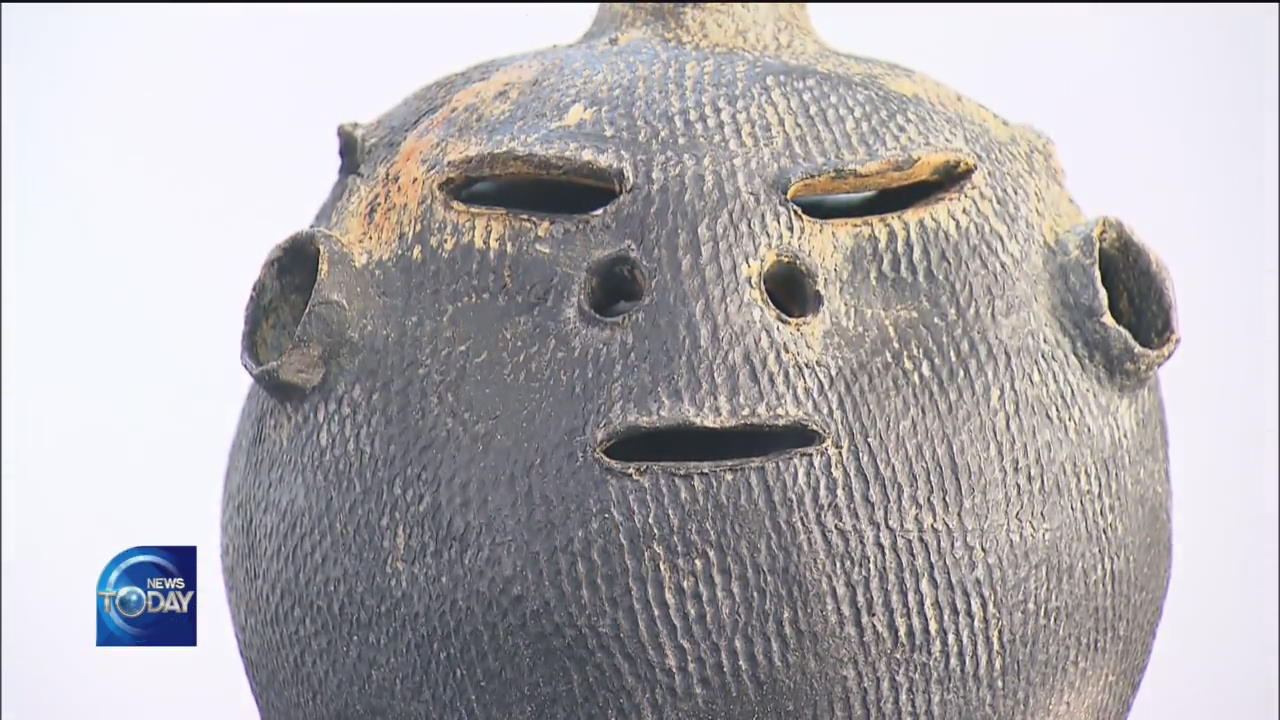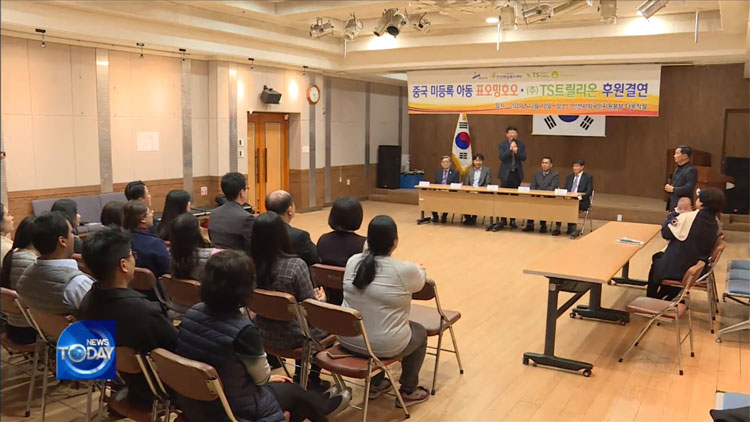DISCOVERY OF FACIAL EXPRESSION RELICS
입력 2019.12.12 (15:10)
수정 2019.12.12 (16:49)
읽어주기 기능은 크롬기반의
브라우저에서만 사용하실 수 있습니다.
[Anchor Lead]
What you are seeing right now are earthenware that were discovered on a relics site of the Silla period in Gyeongsan, Gyeongsangbuk-do Province. These Earthenware that almost resemble facial expressions and wooden tablets containing records of a land survey are presumed to date back to the 6th century. A study is being conducted to find out how they were used at the time.
[Pkg]
Smiling... Absent-minded... And angry... These facial expressions represent simple yet complex and subtle human emotions. All three of them are engraved on a single jar. The excavated earthenware pieces are presumed to date back to the 6th century Silla Kingdom. Experts say no such relics have been found before.
[Soundbite] OH SEUNG-YEON(EXCAVATION ORGANIZATION) : "This excavation is so unique that there is every reason to presume that the relics were used at ancestor worship ceremonies."
Wooden tablets measuring 74 centimeters long have also been discovered in the same pit. Judging by the engraved characters meaning "ravine" and "rice paddy," they are presumed to be official documents that were used before collecting land taxes.
[Soundbite] JEON KYUNG-HO(GYEONGJU NATIONAL RESEARCH INSTITUTE OF CULTURAL HERITAGE) : "The tablets were likely used to grasp land information. This important data points to the possibility that in the 6th century Silla's administrative power included Gyeongsan's neighboring regions as well."
Historians now want to find out the original purpose of the excavation site, as several rare relics were found here at once. The Cultural Heritage Administration plans to find out what the relics were used for and continue excavations at nearby sites. The discovered relics could provide clues to what life was like during the Silla period 1500 years ago.
What you are seeing right now are earthenware that were discovered on a relics site of the Silla period in Gyeongsan, Gyeongsangbuk-do Province. These Earthenware that almost resemble facial expressions and wooden tablets containing records of a land survey are presumed to date back to the 6th century. A study is being conducted to find out how they were used at the time.
[Pkg]
Smiling... Absent-minded... And angry... These facial expressions represent simple yet complex and subtle human emotions. All three of them are engraved on a single jar. The excavated earthenware pieces are presumed to date back to the 6th century Silla Kingdom. Experts say no such relics have been found before.
[Soundbite] OH SEUNG-YEON(EXCAVATION ORGANIZATION) : "This excavation is so unique that there is every reason to presume that the relics were used at ancestor worship ceremonies."
Wooden tablets measuring 74 centimeters long have also been discovered in the same pit. Judging by the engraved characters meaning "ravine" and "rice paddy," they are presumed to be official documents that were used before collecting land taxes.
[Soundbite] JEON KYUNG-HO(GYEONGJU NATIONAL RESEARCH INSTITUTE OF CULTURAL HERITAGE) : "The tablets were likely used to grasp land information. This important data points to the possibility that in the 6th century Silla's administrative power included Gyeongsan's neighboring regions as well."
Historians now want to find out the original purpose of the excavation site, as several rare relics were found here at once. The Cultural Heritage Administration plans to find out what the relics were used for and continue excavations at nearby sites. The discovered relics could provide clues to what life was like during the Silla period 1500 years ago.
■ 제보하기
▷ 카카오톡 : 'KBS제보' 검색, 채널 추가
▷ 전화 : 02-781-1234, 4444
▷ 이메일 : kbs1234@kbs.co.kr
▷ 유튜브, 네이버, 카카오에서도 KBS뉴스를 구독해주세요!
- DISCOVERY OF FACIAL EXPRESSION RELICS
-
- 입력 2019-12-12 15:17:01
- 수정2019-12-12 16:49:34

[Anchor Lead]
What you are seeing right now are earthenware that were discovered on a relics site of the Silla period in Gyeongsan, Gyeongsangbuk-do Province. These Earthenware that almost resemble facial expressions and wooden tablets containing records of a land survey are presumed to date back to the 6th century. A study is being conducted to find out how they were used at the time.
[Pkg]
Smiling... Absent-minded... And angry... These facial expressions represent simple yet complex and subtle human emotions. All three of them are engraved on a single jar. The excavated earthenware pieces are presumed to date back to the 6th century Silla Kingdom. Experts say no such relics have been found before.
[Soundbite] OH SEUNG-YEON(EXCAVATION ORGANIZATION) : "This excavation is so unique that there is every reason to presume that the relics were used at ancestor worship ceremonies."
Wooden tablets measuring 74 centimeters long have also been discovered in the same pit. Judging by the engraved characters meaning "ravine" and "rice paddy," they are presumed to be official documents that were used before collecting land taxes.
[Soundbite] JEON KYUNG-HO(GYEONGJU NATIONAL RESEARCH INSTITUTE OF CULTURAL HERITAGE) : "The tablets were likely used to grasp land information. This important data points to the possibility that in the 6th century Silla's administrative power included Gyeongsan's neighboring regions as well."
Historians now want to find out the original purpose of the excavation site, as several rare relics were found here at once. The Cultural Heritage Administration plans to find out what the relics were used for and continue excavations at nearby sites. The discovered relics could provide clues to what life was like during the Silla period 1500 years ago.
What you are seeing right now are earthenware that were discovered on a relics site of the Silla period in Gyeongsan, Gyeongsangbuk-do Province. These Earthenware that almost resemble facial expressions and wooden tablets containing records of a land survey are presumed to date back to the 6th century. A study is being conducted to find out how they were used at the time.
[Pkg]
Smiling... Absent-minded... And angry... These facial expressions represent simple yet complex and subtle human emotions. All three of them are engraved on a single jar. The excavated earthenware pieces are presumed to date back to the 6th century Silla Kingdom. Experts say no such relics have been found before.
[Soundbite] OH SEUNG-YEON(EXCAVATION ORGANIZATION) : "This excavation is so unique that there is every reason to presume that the relics were used at ancestor worship ceremonies."
Wooden tablets measuring 74 centimeters long have also been discovered in the same pit. Judging by the engraved characters meaning "ravine" and "rice paddy," they are presumed to be official documents that were used before collecting land taxes.
[Soundbite] JEON KYUNG-HO(GYEONGJU NATIONAL RESEARCH INSTITUTE OF CULTURAL HERITAGE) : "The tablets were likely used to grasp land information. This important data points to the possibility that in the 6th century Silla's administrative power included Gyeongsan's neighboring regions as well."
Historians now want to find out the original purpose of the excavation site, as several rare relics were found here at once. The Cultural Heritage Administration plans to find out what the relics were used for and continue excavations at nearby sites. The discovered relics could provide clues to what life was like during the Silla period 1500 years ago.
이 기사가 좋으셨다면
-
좋아요
0
-
응원해요
0
-
후속 원해요
0

















이 기사에 대한 의견을 남겨주세요.